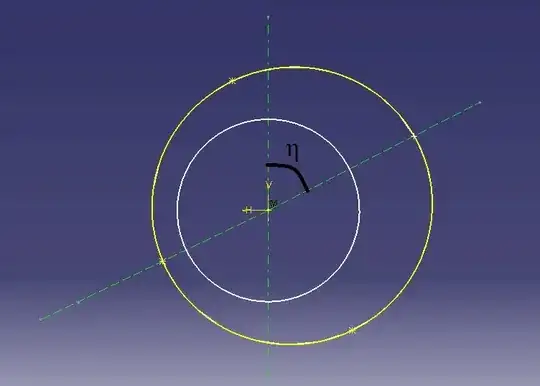I am trying to find the angle of tilts of a screen using projection of a circle from a source $S$. The light beam falls on the photo screen to expose it and what we get is an ellipse with major axis $a$ and minor axis $b$. The light beam is in the form of a cone so what we get is essentially an ellipse on the screen.
The screen tilts with angle $\alpha$ to the vertical axis $y$ and $\beta$ with the horizontal axis $x$. Rotation about the $z$ axis does not affects the shape of the ellipse so it can be ignored for the moment.
The transformed plane can be given by:
$\begin{bmatrix}x_1\\y_1\\z_1\end{bmatrix}=\begin{bmatrix}1&0&0\\0&\cos\alpha&\sin\alpha\\0&-\sin\alpha&\cos\alpha\end{bmatrix}\cdot\begin{bmatrix}\cos\beta&0&-\sin\beta\\0&1&0\\\sin\beta&0&\cos\beta\end{bmatrix}\cdot\begin{bmatrix}\cos\gamma&-\sin\gamma&0\\\sin\gamma&\cos\gamma&0\\0&0&1\end{bmatrix}\cdot\begin{bmatrix}x\\y\\z\end{bmatrix}$
so ignoring $z$ and setting $\gamma = 0$ we get, $$\ x_1=x\cos\beta \ + \ y\sin\alpha \sin\beta $$ and $$ \ y_1=\ y\cos\alpha$$
Now on the screen $P$ is vertical axis and $Q$ is the horizontal axis, $\theta$ is the angle of semi-major axis with horizontal- $Q$. To get the same ellipse as in the projection we can use the shear transformation of an ellipse on the screen:
Rotation transformation gives:
$$P_1 = P\cos\theta \ - \ Q\sin\theta$$
$$P_2 = P\sin\theta \ + \ Q\cos\theta$$
substituting $P_1$ & $P_2$ in ellipse equation with $a$ & $b$ as major and minor axis followed by vertical shear transformation we can get the limits to the ellipse w.r.t angle $\theta$, which are:
$\sqrt{a^2\sin^2\theta +b^2\cos^2\theta } \ $ for the horizontal axis $Q$
$\sqrt{b^2\sin^2\theta +a^2\cos^2\theta } \ $ for the vertical axis $P$
After being done with that, we do the same procedure using $x_1$ and $y_1$ to apply the transformation to a circle using equation of a circle. After the shear transformation of those equation we get the equations giving the maximum limit:
$\sqrt{a^2\cos^2\alpha +a^2\sin^2\alpha \sin^2\beta } \ $ for horizontal axis
$\sqrt{a^2\cos^2\alpha }\ $ for vertical axis
For getting $\alpha$ and $\beta$ in terms of $\theta$ we use the above equations as the maximum extent of both the cases must be equal to get the same ellipse.
so:
$\sqrt{a^2\cos^2\alpha +a^2\sin^2\alpha \sin^2\beta }=\sqrt{b^2\cos^2\theta +a^2\sin^2\theta }$
and
$\sqrt{a^2\cos^2\alpha }=\sqrt{a^2\cos^2\theta +b^2\sin^2\theta }$
Solving these equation we get:
$$\alpha =\cos^{-1}\sqrt{\cos^2\theta +\frac{b}{a^2}^2\sin^2\theta }$$
$$\beta =\sin^{-1}\sqrt{\frac{\cos^2\theta \left(\frac{b^2}{a^2}-1\right)}{\sin^2\theta \left(1-\frac{b^2}{a^2}\right)-1}}$$
It turns out it is not giving the correct $\alpha$ & $\beta$ values with $\theta$ but when viewed from the point $S$ along the $z$ axis we get the following image in which the small circle is the circle that is being projected and the bigger ellipse(which would appear as a circle) is the projected ellipse on the screen when viewed from point $S$.
Using the angle $\eta$, that is the angle between the vertical axis and the ellipse major axis when viewed from point $S$, in the above angle equations ($\alpha, \beta$) in the place of $\theta$ and keeping the other parameters same, we observe that it gives the correct value of $\alpha$ & $\beta$
Now in general case we cannot use this method ($\eta$) to find the angles as we would just have the screen photo image of the ellipse. Can this $\eta$ be related to $\theta$ by any means or what can be done to change the angles equation to get the correct value?
I am using a software to simulate this so I can see from the source position and get the $\eta$ angle but in practical case it can not be done as we will just have the photo of the ellipse. This is being done to correct the photo(screen) plane using $\alpha$ & $\beta$ so that it can reach the ideal state if being parallel to the plane of the circle.

